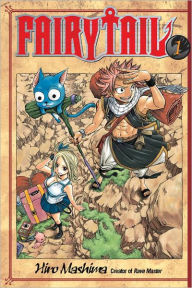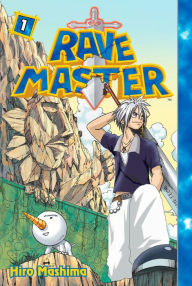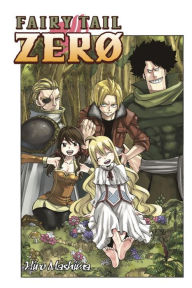A Magical Manga Reaches a Fairy Tail Ending: Talking with Hiro Mashima
Fairy Tail, Volume 1
Fairy Tail, Volume 1
By Hiro Mashima
In Stock Online
Paperback $10.99
“I actually don’t really like to be around people too much,” Fairy Tail creator Hiro Mashima said, settling in for an interview with a group of reporters at New York Comic Con. “I don’t even like to talk to people too much, but through my work with manga I get to communicate with the whole wide world, which I think is incredible.”
Indeed, Fairy Tail has consistently been one of the top selling manga in Japan and in the U.S. When Mashima appeared at New York Comic Con in 2011, over 300 fans packed into the panel room to see him. At this year’s NYCC, he was honored at the Harvey Awards.
Despite his professed shyness, Mashima seemed at ease and often laughed as he answered the questions or threw in little asides—including the fact that he realized at an autograph session that he had forgotten how to draw the characters from his earlier series, Rave Master.
“I actually don’t really like to be around people too much,” Fairy Tail creator Hiro Mashima said, settling in for an interview with a group of reporters at New York Comic Con. “I don’t even like to talk to people too much, but through my work with manga I get to communicate with the whole wide world, which I think is incredible.”
Indeed, Fairy Tail has consistently been one of the top selling manga in Japan and in the U.S. When Mashima appeared at New York Comic Con in 2011, over 300 fans packed into the panel room to see him. At this year’s NYCC, he was honored at the Harvey Awards.
Despite his professed shyness, Mashima seemed at ease and often laughed as he answered the questions or threw in little asides—including the fact that he realized at an autograph session that he had forgotten how to draw the characters from his earlier series, Rave Master.
Fairy Tail, Volume 63
Fairy Tail, Volume 63
By Hiro Mashima
In Stock Online
Paperback $10.99
Perhaps he was so relaxed because Fairy Tail has finally come to an end: the serialization in Weekly Shonen Magazine ended in July, and the last volume, volume 63, is due out in December in Japan; the English edition will be out in January 2018.
From Mashima’s description of his creative process, it sounds like Fairy Tail was created with more than a dash of improvisation. “I honestly didn’t have any of the last scenes of the story in my mind when I started the series,” he said. “The fact that I didn’t know where the story [was] going was actually the best part about working on this series. For example, one chapter ends with a huge cliffhanger with the characters in a real tight spot. What’s going to happen next? That’s actually my question to myself—and I really have to think about this.”
Not surprisingly, Mashima is not a stickler for continuity. “It’s more important to me to make the story exciting by really portraying the emotions of each character,” he said. “If the fans find some flaws in the continuity or the plots, I’m actually excited to know that people are reading that much into it.”
He also isn’t averse to changing his characters’ costumes, usually because he doesn’t like something about them. “Sometimes I go back to thinking maybe the previous design was better, so I kind of go back and forth between them,” he said.
Mashima does review his first drafts with his editor. “If the editor says it is not good, I would ask the reason why,” he said. “That creative process is very important to the work I do.”
That doesn’t mean they always agree: “Sometimes we get in a conflict where the editor says one thing and I disagree and I push forward with what I believe is the best case scenario and I don’t succeed and I feel like ‘Oh, I should have listened to him.’ Sometimes when I am stuck on an idea he gives me pretty prompt advice which really helps me get over those places.”
Perhaps he was so relaxed because Fairy Tail has finally come to an end: the serialization in Weekly Shonen Magazine ended in July, and the last volume, volume 63, is due out in December in Japan; the English edition will be out in January 2018.
From Mashima’s description of his creative process, it sounds like Fairy Tail was created with more than a dash of improvisation. “I honestly didn’t have any of the last scenes of the story in my mind when I started the series,” he said. “The fact that I didn’t know where the story [was] going was actually the best part about working on this series. For example, one chapter ends with a huge cliffhanger with the characters in a real tight spot. What’s going to happen next? That’s actually my question to myself—and I really have to think about this.”
Not surprisingly, Mashima is not a stickler for continuity. “It’s more important to me to make the story exciting by really portraying the emotions of each character,” he said. “If the fans find some flaws in the continuity or the plots, I’m actually excited to know that people are reading that much into it.”
He also isn’t averse to changing his characters’ costumes, usually because he doesn’t like something about them. “Sometimes I go back to thinking maybe the previous design was better, so I kind of go back and forth between them,” he said.
Mashima does review his first drafts with his editor. “If the editor says it is not good, I would ask the reason why,” he said. “That creative process is very important to the work I do.”
That doesn’t mean they always agree: “Sometimes we get in a conflict where the editor says one thing and I disagree and I push forward with what I believe is the best case scenario and I don’t succeed and I feel like ‘Oh, I should have listened to him.’ Sometimes when I am stuck on an idea he gives me pretty prompt advice which really helps me get over those places.”
Rave Master, Volume 1
Rave Master, Volume 1
By Hiro Mashima
In Stock Online
eBook
$9.99
$10.99
There are a few things that set Fairy Tail apart from other shonen manga. One is Mashima’s reluctance to kill off the characters. “This has to do with the fact that in my previous work, Rave Master, a lot of characters died, and it turned out to be a sad story,” he said. The fate of manga that run in weekly magazines is heavily dependent on readers’ polls, and the death of an important character usually evokes a strong reaction. “Knowing that, I really wanted to make sure that people don’t die in my series,” he said.
Another feature of Fairy Tail is that the women tend to be strong, sexy, and self-confident all at the same time. Mashima said that’s because that’s the sort of woman he likes.
As for the villains, he had a lot to say about Zeref Dragneel. “I didn’t really want to go for a typical bad guy,” he said. “I combined all the elements and references that I have been cultivating in myself and inserted them into this character, and it turned into this highly complex character called Zeref. Honestly, he is full of contradictions.” The character he wishes he could have spent more time on is another villain, Acnologia. “In my mind, I had a lot deeper setting for this character, but then I had to prioritize the momentum of the story from the main character’s point of view, so I couldn’t get into that,” he said—although he hinted that he may return to Acnologia’s story in the future.
“One of the things that I learned, and I feel I succeeded [at], in Fairy Tail, is to develop lots and lots of characters with very unique personalities,” he said. “That [is] something I would like to apply [to] my next series too.”
There are a few things that set Fairy Tail apart from other shonen manga. One is Mashima’s reluctance to kill off the characters. “This has to do with the fact that in my previous work, Rave Master, a lot of characters died, and it turned out to be a sad story,” he said. The fate of manga that run in weekly magazines is heavily dependent on readers’ polls, and the death of an important character usually evokes a strong reaction. “Knowing that, I really wanted to make sure that people don’t die in my series,” he said.
Another feature of Fairy Tail is that the women tend to be strong, sexy, and self-confident all at the same time. Mashima said that’s because that’s the sort of woman he likes.
As for the villains, he had a lot to say about Zeref Dragneel. “I didn’t really want to go for a typical bad guy,” he said. “I combined all the elements and references that I have been cultivating in myself and inserted them into this character, and it turned into this highly complex character called Zeref. Honestly, he is full of contradictions.” The character he wishes he could have spent more time on is another villain, Acnologia. “In my mind, I had a lot deeper setting for this character, but then I had to prioritize the momentum of the story from the main character’s point of view, so I couldn’t get into that,” he said—although he hinted that he may return to Acnologia’s story in the future.
“One of the things that I learned, and I feel I succeeded [at], in Fairy Tail, is to develop lots and lots of characters with very unique personalities,” he said. “That [is] something I would like to apply [to] my next series too.”
Fairy Tail Zero
Fairy Tail Zero
By Hiro Mashima
In Stock Online
Paperback $10.99
Fantasy is Mashima’s favored genre, and he said he was inspired by RPG games such as Final Fantasy and Dragon Quest. Within that genre, though, each of his series is different. Rave Master was about “a group of people who had to save the whole world,” he said, while Fairy Tail is more about friendship. “If I were to try another fantasy series, I would like to try a different approach again,” he said.
Although Fairy Tail has been a big seller with multiple spinoffs, and won the prestigious Kodansha Manga Prize in 2009, Mashima is humble about it. In talking about his next series, he said, “In Japan there is kind of a jinx: that after the first big hit, your next series is going to be a flop. But I. personally. am not worried about it. There is one reason that I am not worried: I personally don’t think Fairy Tail was a giant success. So when I think in such ways, I feel no pressure to work on a brand new series.”
His fans beg to differ, of course. As the interview came to an end, Mashima admitted his favorite thing about the Fairy Tail fandom was “everybody’s eyes shining”:
“I get really happy just looking at them,” he said. And then he headed off to his next event, a panel and drawing session for an auditorium filled with his fans.
Fantasy is Mashima’s favored genre, and he said he was inspired by RPG games such as Final Fantasy and Dragon Quest. Within that genre, though, each of his series is different. Rave Master was about “a group of people who had to save the whole world,” he said, while Fairy Tail is more about friendship. “If I were to try another fantasy series, I would like to try a different approach again,” he said.
Although Fairy Tail has been a big seller with multiple spinoffs, and won the prestigious Kodansha Manga Prize in 2009, Mashima is humble about it. In talking about his next series, he said, “In Japan there is kind of a jinx: that after the first big hit, your next series is going to be a flop. But I. personally. am not worried about it. There is one reason that I am not worried: I personally don’t think Fairy Tail was a giant success. So when I think in such ways, I feel no pressure to work on a brand new series.”
His fans beg to differ, of course. As the interview came to an end, Mashima admitted his favorite thing about the Fairy Tail fandom was “everybody’s eyes shining”:
“I get really happy just looking at them,” he said. And then he headed off to his next event, a panel and drawing session for an auditorium filled with his fans.



